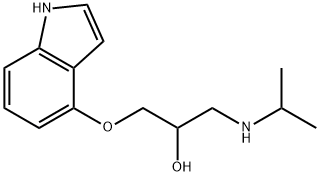Mixed β-adrenergic blocker and serotonin 5HT1A-receptor antagonist. Antihypertensive; antianginal; antiarrhythmic; antiglaucoma.
Pindolol, like nadolol, is a nonselective β-adrenoblocker. It possesses antianginal, antihy�potensive, and antiarrythmic action. It is used for arterial hypertension, angina stress (pre�venting attacks), supraventricular tachycardia, tachsystolic form of atrial fibrillation, and
superventricular extrasystole.
ChEBI: A member of the class of indols which is the 2-hydroxy-3-(isopropylamino)propyl ether derivative of 1H-indol-4-ol.
4-Hydroxyindole is obtained by debenzylation of 4-benzyloxyindole with hydrogen in the presence of a 5% palladium catalyst on aluminium oxide.
10.0 g of 4-hydroxyindole and subsequently 7.4 ml of epichlorohydrin are added while stirring in an atmosphere of nitrogen to a solution of 2.73 g of sodium hydroxide in 65 ml of water. Stirring is effected at room temperaturefor a further 15 h, the reaction mixture is extracted 4 times with 50 ml of methylene chloride and the combined organic layers which have been dried over magnesium sulfate are evaporated at reduced pressure. So 3-chloro-1(4-indolyloxy)-2-propanol is obtained.
The 3-chloro-1-(4-indolyloxy)-2-propanol is dissolved in 50 ml of toluene and 50 ml of isopropylamine and heated to the boil for 45 h. Evaporation to dryness is effected in a vacuum, the residue is shaken out thrice between ethyl acetate and a 1 N tartaric acid solution and a 5 N sodium hydroxide solution is then added to the combined tartaric acid phases until an alkaline reaction is obtained. The alkaline solution is shaken out thrice with 50 ml of methylene chloride, the extracts are dried over magnesium sulfate and the solvent evaporated in vacuum. The residue is crystallized from ethyl acetate/ether to give the 4-(2-hydroxy-3-isopropylaminopropoxy)indole.
5-HT 1A/1B ? receptor antagonist, with roughly equal affinity for each subtype. A partial agonist at mouse and human β 3 -adrenoceptors.
β1-adrenoceptor antagonist; putative 5-HT1A serotonin receptor agonist; vasodilator.
Beta-blocker:
Hypertension
Angina
Potentially hazardous interactions with other drugs
Anaesthetics: enhanced hypotensive effect.
Analgesics: NSAIDs antagonise hypotensive effect.
Anti-arrhythmics: increased risk of myocardial
depression and bradycardia; increased risk of
bradycardia, myocardial depression and AV block
with amiodarone; increased risk of myocardial
depression and bradycardia with flecainide.
Antidepressants: enhanced hypotensive effect with
MAOIs.
Antihypertensives; enhanced hypotensive effect;
increased risk of withdrawal hypertension with
clonidine; increased risk of first dose hypotensive
effect with post-synaptic alpha-blockers such as
prazosin.
Antimalarials: increased risk of bradycardia with
mefloquine.
Antipsychotics: enhanced hypotensive effect with
phenothiazines.
Calcium-channel blockers: increased risk of
bradycardia and AV block with diltiazem;
hypotension and heart failure possible with
nifedipine and nisoldipine; asystole, severe
hypotension and heart failure with verapamil.
Cytotoxics: possible increased risk of bradycardia
with crizotinib.
Diuretics: enhanced hypotensive effect.
Fingolimod: possibly increased risk of bradycardia.
Moxisylyte: possible severe postural hypotension.
Sympathomimetics: severe hypertension with
adrenaline and noradrenaline and possibly with
dobutamine.
Several metabolites of pindolol formed in vitro are
detected after a 24 h incubation of human hepatocytes
in both pure culture and co-culture by adding rat liver
epithelial cells. The hepatocytes are able to oxidize
the isopropyl amine moiety and the pyrrole ring of the
indole moiety and conjugate pindolol as sulfates and
glucuronides.
Pindolol (Visken) is extensively absorbed from the
gastrointestinal tract. First-pass metabolism is estimated
at about 15%, and its plasma half-life is on the order of
3 to 4 hours.The binding of pindolol to plasma proteins
is approximately 50%.The metabolic fate of pindolol is
not completely understood, although 50% of an administered
dose is recovered, primarily in the urine, as unchanged
drug.



